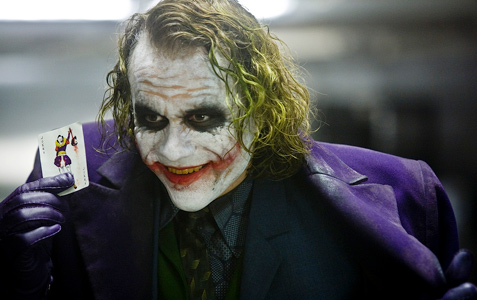Vaudeville Villains: Why Hollywood has a villain problem

Stories are only as good as the problems their protagonist must overcome. The dramatic conflict that arises must truly be an interesting and formidable opponent that stops the hero from living a peaceful life or seeing his dreams fulfilled. To know a story is to know that central conflict, and in those stories where the conflict is perpetrated or predicated on the actions of another character, those are truly big shoes to fill for the antagonist. Or, put another, simpler way: stories are only as good as their villains.
True, the protagonists must be understandable and sympathetic to some regard, and their dreams must be easily grasped and shared by the audience. To have a blank slate as a hero is to have a large gap at the center of plot. But assuming that the hero is easily drawn and understood, their actions come about and their characters are revealed when drawn into conflict (and contrast) with the villain. It’s a pretty central tenet of storytelling, and yet one that has woefully been forgotten by Hollywood in the past few years. There have been exceptions, but by and large, while studios have been able to show a villain’s threat with greater ease thanks to CGI, rendering that villain interesting and memorable has proven far more difficult.
But why is this? It used to be that villain roles were what attracted big name stars and talented actors to blockbusters (and it still does, see Oscar Isaac in “X-Men: Apocalypse”) because they were so much fun, so intricate, so effortlessly memorable. Hans Gruber from “Die Hard,” the Xenomorph from “Alien,” even a stationary red eye like HAL from “2001: A Space Odyssey” – these are all immensely memorable villains with complicated psyches (or unknown mindsets) that were designed to look cool and portrayed in such a fashion that was chilling but still fun for audiences. In fact, at one point, the villains became so popular in slasher films that they overtook the audience surrogate and became a form of anti-hero; audiences weren’t turning out for the nameless teens being haunted by a boogeyman, they were coming for the boogeyman himself in the form of Jason, Freddy and Michael Myers.
So what happened to those days? What happened to having a villain that brought out the best in a hero? A villain who had a real sense of character or purpose, and who stayed with people well after the end credits? Whither are those halcyon days of evil where audiences could see Gary Busey fight Mel Gibson, or Linda Hamilton square off against Arnold Schwarzenegger? Hell, even General Zod (the Terence Stamp version) was memorable in his disco outfits as well as his grand speeches from the Oval Office. But now they have all been replaced by generic apocalypses and world-destroyers. Because although it’s easier than ever to show destruction and an evil plan being carried out, it’s harder to make audiences care about the minds behind the plot.
Part of this has to do with time management, of all things. Even though modern blockbusters are now longer than they’ve ever been, with running times pressing up against three hours, there’s still an economy of screen time to consider. And part of the issue of the disservice to villains is that so many other elements need to be set up as well. Not only does the lead have to be introduced, but also the romantic angle and the buddies and friends who trade quips with the lovable protagonist. Then there’s the work establishing the world or, if one already exists, establishing the characters within that world. And of course there’s all the work of setting up the larger world so that there is ample fuel for a sequel (or a bigger franchise).
“Captain America: Civil War” is a very good blockbuster, but in having to do heavy lifting with introducing characters and giving every character their due, plus setting up what’s next for the Marvel Universe, Zemo (Daniel Brühl) was bound to get shortchanged. And he actually fares probably the best out of most of Marvel’s generic villains (with the lone exception of Tom Hiddleston’s Loki, who is clearly the most fun and colorful villain of the universe), as he has a pretty brilliant plan and also a compelling backstory. But he’s also fairly forgettable. No quotable lines from him, no iconic “Zemo scene” that people will remember years from now. He’s effective, but not memorable; he services the film’s plot, but the film does him no favors. With so much going on in that movie, and its role in the expanded universe, the villain is left behind. This was the same for “Batman v Superman: Dawn of Justice,” “Suicide Squad,” all of the “Transfomers” movies, and most of the Marvel Studios films (Malekith the Dark Elf, anyone?). There’s simply too much going on to give the villains more to do.
Another issue for the lack of memorable villains in recent blockbusters is that their plans tend to be the same: world destruction. There’s a beam that shoots up into the sky that lays waste to everything around it, resulting in a bunch of CGI buildings falling apart that conjure up well-known images of familiar disasters or some such nonsense. There’s very little nuance for a creature that wants to destroy the world, unless they’re doing it in a very original (or unique) way. Gozer from the original “Ghostbusters” had a sleek design, but it also had a great way of bringing about the apocalypse: a giant marshmallow man stomping through New York. It’s ridiculous, certainly, but it is memorable, and the cartoon look on the foam creature is also a design choice that is easily grafted onto audiences’ memory banks.
Add some changes to just energy blasts that reduce the world to rubble and perhaps the villains themselves will change as well. This also has to do with escalation in blockbusters – the films always have to top each other (both the previous franchise installment and other blockbusters out there), so the destruction has to be even greater than the competition. The fact is that audiences don’t crave disaster porn as much as filmmakers think; they actually want to care about what is being destroyed and why.
The problem most blockbusters face with their villains is that they are mere cogs in the plot machine. The well-handled villains of recent time – Heath Ledger’s Joker, Anton Chigurh, Loki, Dr. Octopus, Kylo Ren – aren’t there to simply initiate or take care of something in the plot. They don’t exist to serve the plot; they exist to paint a better picture of the protagonists, to complete them by showing a dark reversal. They exist. That may sound grandiose, but it is true – great villains exist in the world and are memorable because they are fully fleshed out, with excellent talking points that are almost persuasive or bone-chillingly terrifying but nonetheless shaped by a very specific perspective. By reducing villains to nothing more than the first domino knocked over to set off a chain of events that leads to some spectacular F/X shot, filmmakers are cheapening the experience and the stories they seek to tell. Many talented filmmakers are looking to tell great stories – perhaps they need to first consider a great villain.
Related Posts
Comments Off on Vaudeville Villains: Why Hollywood has a villain problem
Posted in: Entertainment, Movies
Tags: film villains, movie villains, The Joker








